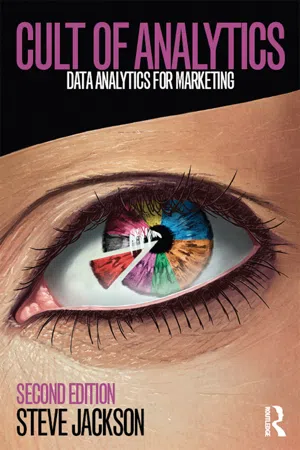Marketing KPIs
Marketing KPIs, or Key Performance Indicators, are specific metrics used to measure the effectiveness of marketing efforts. These indicators help businesses evaluate the success of their marketing campaigns and strategies by tracking important data such as conversion rates, customer acquisition costs, and return on investment. By analyzing KPIs, marketers can make informed decisions to optimize their marketing activities and drive better results.
7 Key excerpts on "Marketing KPIs"
- eBook - ePub
Marketing Strategy
Overcome Common Pitfalls and Create Effective Marketing
- Jenna Tiffany(Author)
- 2021(Publication Date)
- Kogan Page(Publisher)
...While for the vanity metric the campaign has been in some part successful, the actionable metric (website visits) that should be the KPI tells a very different (and much more insightful) story, as Victoria Peppiatt explains: Marketing teams are always looking to quantify the effectiveness of their work and improve KPIs, but not at any cost. The key is to improve metrics without resorting to cheap clickbait tactics, and ensure the improvement lasts not just today, but tomorrow as well. Consistency in the application of your chosen KPIs is crucial. Throughout the business, if the same KPI is being used, it must be measured in the same way. This is the same when comparing marketing campaigns. Otherwise, you’ll end up comparing apples with pears and could draw incomplete or incorrect conclusions. Let’s go through the common KPIs. Marketing KPIs Marketing KPIs involve interactions (or additional data) from outside your content itself. They can be a bit more complicated to work out, but are essential to indicate how well each channel is contributing to the brand’s overall marketing and business objectives. For example, if email drives visitors to your website, and plenty of those visitors convert, this would indicate that email is performing well – even though the KPI figures are drawn primarily from outside the email itself. CONVERSION RATE (CR) Any piece of campaign content has a goal. The conversion rate indicates the extent to which it achieves its goal. For example, if the goal is to get customers to click through to the website, a high click-through rate will double as a high conversion rate. Making a purchase is a common goal for marketing content, particularly for e-commerce companies. To understand the CR for this goal, marketers need to look to website statistics...
- eBook - ePub
- William Leake, Lauren Vaccarello, Maura Ginty(Authors)
- 2012(Publication Date)
- Sybex(Publisher)
...It’s a far more controllable problem that desperately needs your attention and is likely solved by using modern best practices on your landing pages. Before we review the essential warning signs informed by the data of traffic acquisition and conversion optimization, let’s start with the numbers that set your warning signal radar. If you know the purpose of your site, site section, or campaign, you need to align it to the core measures that benchmark that marketing goal as a success or failure. Key Performance Indicators and Other Meaningful Reports Your actions in web analytics are dictated by your role and the actions you can take, the language of your business line and larger company, and the key performance indicator at hand. Any marketing strategy should have a marketing goal. The goal might be to get people to the site. It might be to compare solutions—either yours to your own or to your competitors. White papers, product trials, freemium to premium, and direct sales are examples. You know the drill. And you read the section on sales funnel. start feature Note : Everything you do should start with goals, from strategy to execution. If you don’t know the purpose of your marketing efforts, how can you measure success and optimize? end feature With key performance indicators (KPIs), numbers reflect marketing meaning (see Figure 7-1). In the same way that 42 alone is not the answer to life, the universe, and everything, the raw data number of.0042 does not state how close you are to meeting your online marketing goal. The numbers matter only when they relate to a purpose where you can actually change the intended behavior. start figure Figure 7-1: KPI dashboard end figure A good KPI is correct for the context, and you need to gather very little information to express how close you stand to your goal...
- eBook - ePub
Social Media Metrics
How to Measure and Optimize Your Marketing Investment
- Jim Sterne(Author)
- 2010(Publication Date)
- Wiley(Publisher)
...It is now indicative of value, importance, or a change in results. If that metric is central to the well-being of the organization, it might be considered a Key Performance Indicator (KPI). It might be worthy of daily e-mail updates, dashboard placement, and iPhone App notifications. To be a KPI, it must indicate how well your organization’s goals are being served. Therein lies the rub—the downfall of web measurement people everywhere: ill-defined objectives. Without context, your measurements are meaningless. Without specific business goals, your metrics are meaningless. Proceed Ye No Further if Ye Have No Goals It is crucial to map out your specific business goals before embarking on a social media program. As Yogi Berra put it, “If you don’t know where you are going, you will wind up somewhere else.” Companies that tout their “success” because they track the number of friends and followers will never compete effectively with those who track sales and profits gained from reaching out to their followers. You want a goal? Income’s a great goal—but it’s not alone. THE BIG THREE BUSINESS GOALS It’s time to get very high-level. There are only three true business goals (Figure 1.1). They are all that matters in the long run. If the work you do does not result in an improvement to one or more of these Big Three Goals, then you are wasting your time, wasting money, spinning your wheels, alienating customers, and not helping the organization. You may be covering your backside and building your empire, but in the long run you will not ensure your status as an employee. Figure 1.1 Your focus should always be on either increasing revenue, lowering costs, or improving customer satisfaction. Doing all three would be just fine. There are many measurable elements that indicate whether you are improving on one or more of these Big Three Goals...
- eBook - ePub
Cult of Analytics
Data analytics for marketing
- Steve Jackson(Author)
- 2015(Publication Date)
- Routledge(Publisher)
...3 Key performance indicators DOI: 10.4324/9781315734743-4 Everything that can be counted does not necessarily count; everything that counts cannot necessarily be counted. Albert Einstein 3.1 What are KPIs? According to Einstein, success is not the opposite of failure. What he meant was you have to figure out why things fail with as much clarity as figuring out why things work and this is what key performance indicators (KPIs) help you to do. There are two types of KPI: the visionary KPI and the tactical KPI. Visionary KPI The visionary KPI reflects what your company is trying to achieve. It’s the big hairy audacious goal (BHAG) 1 defined as a metric. In his book The One Thing You Need To Know (Free Press, 2005), Marcus Buckingham described this as the “Core Score.” In it he asked Sir David Ramsbotham, then the chief inspector of Her Majesty’s prisons, what their key metric was. It turns out that in Sir David’s prison reform process he changed the metric from “number of escapees” to “number of repeat offenders”. In doing so he completely changed the culture of the prison system. This visionary KPI is one that drives change or helps your company build its culture. This has to be defined by your leaders as part of the strategy. Tactical KPI The tactical KPIs depend on the goals and objectives of spokes – covered in Chapter 1 and here in Chapter 3. This chapter will cover how to develop management level KPIs starting with their goals and objectives, applying industry thinking and a workshop process. Digital Analytics Association definition The Digital Analytics Association (DAA) has developed standard terms and definitions around KPIs. Since the purpose of the DAA is to standardise the approach to using web analytics I would advise you follow their definition in your tactical workshops. There are three types of analytics metrics – counts, ratios, and KPIs: Count – the most basic unit of measure; a single number, not a ratio...
- eBook - ePub
Understanding Social Media
How to Create a Plan for Your Business that Works
- Damian Ryan(Author)
- 2015(Publication Date)
- Kogan Page(Publisher)
...In this chapter we consider these three steps in more detail, including examples. Setting KPIs Before setting your KPIs you need to agree clearly on the objectives of the service. The objectives are usually one or a multiple of the following: Brand building: create awareness among new target segments and remind existing customers about your brand, products and services, including sign-up to Facebook pages and other opt-in engagement programmes. Loyalty: engage with existing customers to buy more of your services and/or more frequently. Driving footfall: get people to your store (or other venue), whether it is online or in a retail store. Transactional: generate purchases from the target audience of the service online or in a store (or a combination thereof). Customer service perception: improve the customer satisfaction and propensity to buy through enhancing the interaction with the brand. Each objective can be translated into measurable KPIs: Brand building: audience reach measured through, for example, ad displays, unique site visits, app downloads, video views and Facebook likes. Loyalty: engagement through, for example, sessions per user, time spent, return rate, sharing of content, liking content, sign-ups to opt-in programmes, time spent with a specific product or service. Driving footfall: visits to store, such as the number of customers who went to the online or physical store/venue. Transactional: for example, customers who purchase a product or service can be measured by voucher redemption rate, payments made, conversions achieved. Customer satisfaction: customer feedback of the service, such as app store ratings and reviews, customer survey results. Finally, there are also some non-functional KPIs such as average loading time, service uptime, page/app errors and so. on. Tools to measure success Once the KPIs have been agreed upon, the next step is to agree how they should be measured...
- eBook - ePub
Libraries and Key Performance Indicators
A Framework for Practitioners
- Leo Appleton(Author)
- 2017(Publication Date)
- Chandos Publishing(Publisher)
...Key performance Indicators, on the other hand, are a set of these measures which are the most critical (critical success factors) for achieving successful outcomes. Characteristics of KPIS are as follows: • They are nonfinancial measures • They are measured frequently (e.g. daily, weekly) • They would be acted upon by the head of the library service • They clearly indicate what action needs to be taken to remedy the situation if negative or adverse performance is indicated • They have a significant impact on achieving outcomes and results • They tie responsibility down to a team A KPI will have some or all of these characteristics. It is difficult to list a set of definitive KPIs as they would be relative to the desired outcomes, and strategic drive of an individual library or organisation. Suffice to say they would not be dissimilar to some of the performance indicators already listed, but the context and strategic priority of the respective library and information service would need to be taken into account. The following chapter will provide some of this context as it looks at five different case studies and how Key performance Indicators can be applied in different library and information environments. References ☆ Brophy P. Measuring library performance: Principles and techniques. London: Facet Publishing; 2006. Corrall S. Strategic management of information services: A planning handbook. London: Aslib; 2000. Goulding A. Libraries and social capital. Journal of Librarianship and Information Science. 2004;36(1):3–6. Hernon P., Altman E. Assessing service quality: Satisfying the expectations of library customers. Chicago, IL: American Library Association; 2010. Holmes A., Parsons F. The institutional HE quality perspective...
- eBook - ePub
How to Measure Digital Marketing
Metrics for Assessing Impact and Designing Success
- L. Flores(Author)
- 2013(Publication Date)
- Palgrave Macmillan(Publisher)
...By definition, this provides the most effective and efficient brand experience strategy. Although metrics and KPIs may greatly vary per media, contact or touchpoint, what are the key concepts you want brands to pay attention to? MCA metrics per media, contacts or touchpoints do vary by markets, categories, and target groups. Using a common currency system, MCA metrics are linked to deliver a validated chain of the following indicators: the influence of each/all contacts, reported in a common currency the capacity to differentiate each and every contact the brand ability to engage through each and every contact the brand ability to mix contacts in order to deliver the most engaging brand experience. Integration studied each of its MCA indicators to validate the entire data chain, and from the same metrics delivered: The KPI for the management of the enterprise The diagnostics indicators for the brand and marketing communication experts. The KPIs for the management of the enterprise report on the fundamental contribution of marketing to the business and they are unambiguously connected to the dollars: 1 How well are we engaging our customers? 2 How well are we converting engagement into sales? 3 How cost efficient is the marketing function? The diagnostics indicators for the brand and marketing communication experts are a level down from executive dashboards and contain information on causes (factors) that determine the outcome of brand engagement. Full treatment of these indicators is beyond the scope of this interview and can be found in detail in the MCA Handbook (www.integration-imc.com). To your knowledge, is there one magic bullet KPI that could measure the impact and ROI of marketing? Marketing ROI is an elusive measure that the marketing community has been struggling with for a long time, and the fact that we don’t have an accepted method is not for lack of trying...






